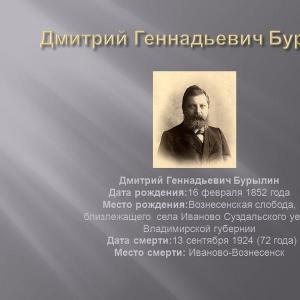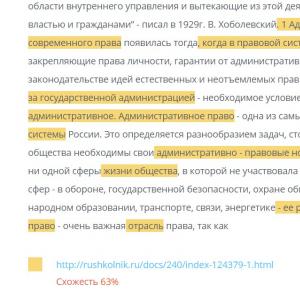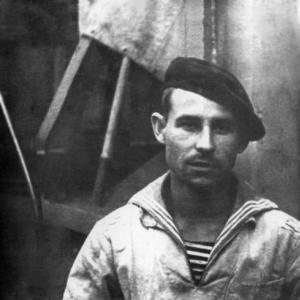Turbulent fluid movement. Specific values \u200b\u200bof Reynolds numbers and their use
Turbulent flow
Turbulent flow
flow of a liquid or gas, characterized by a chaotic, irregular movement of its volumes and their intensive mixing ( cm. Turbulence), but generally smooth, regular. The formation of T. t. Is associated with the instability of the laminar flow at large Reynolds numbers ( cm. Transition of laminar flow to turbulent). In the study of turbulence, a distinction is made between near-wall flows (a turbulent boundary layer, flows in pipes and channels) and free flows (turbulent jets, aerodynamic wakes, and mixing layers).
T. t. Are widespread in natural phenomena and technical devices and are characterized by huge, compared with laminar flows, values \u200b\u200bof the transfer coefficient ( cm. Transportable properties of the medium), which leads to much (ó) higher friction forces ( cm. Turbulent friction), heat and mass flows. In many technical applications, this is harmful and forces one to look for ways to reduce them ( cm., for example, Laminarization of the boundary layer); in some cases, on the contrary - it is the realization of T. t. leads to a decrease in the aerodynamic resistance of the body ( cm. Resistance crisis). On the other hand, many technical devices (aircraft engines, ejectors, etc.) use a high intensity of mixing processes and an increased propagation speed. chemical reactions (for example, combustion) in T. t. Regularities of T. t. often determine the limit of improvement of technical devices.
Following O. Reynolds, the instantaneous values \u200b\u200bof the gas-dynamic variables in T. t. Are divided into 2 terms - the averaged value and its pulsation (for example, the components ui of the velocity vector and is represented in the form
ui \u003d + u (′) i, and the pressure
p \u003d + p ",
where is the sign<...> denotes a value averaged over time, the stroke is its ripple). In this case, the thermal mass is determined, on the one hand, by the field of averaged gas-dynamic variables and, on the other hand, by the statistical parameters of the pulsations - the kinetic energy of the pulsations
E \u003d 3/2 or related turbulence intensity
(ε) = ½/ , the integral scale of turbulence L, which characterizes the size of the eddies containing the bulk of the energy E or, in the general case, all possible moments of pulsating quantities that are the averaged values \u200b\u200bof their products -
, ,
and so on - and related to all possible points in space and times, or probability density functions - P (u1), P (u1, u2), etc. The parameters of the pulsations can vary over a wide range. For example, in the working parts of wind tunnels, depending on their type (ε) \u003d 0.01-2%; on the axis of long pipelines (ε) \u003d 4-5%, L \u003d (0.03-0.04) d (d - pipe diameter); in WFD paths, the values \u200b\u200bof b can reach 10-20%, and L - (0.1-0.3) d.
In 1894 he obtained equations for the average velocity (Reynolds equations)
(i, (α) \u003d 1, 2, 3) and the equation for the turbulence energy. Here (ρ) is the density; (ν) - kinematic viscosity; x (α) - coordinates (by (α) summation is meant); t is time. These equations differ from the Navier - Stokes equations by the presence of additional turbulent stresses (Reynolds stresses) τi j \u003d - ρ caused by pulsation motion. In contrast to molecular stresses, which are determined by the local characteristics of the averaged flow, the Reynolds stresses are associated with large-scale turbulence and therefore at each point of the flow depend on the distribution of the averaged velocity and the features of the pulsating motion in its sufficiently large vicinity.
The concept of turbulent viscosity, introduced by the French scientist J. Boussinesq in 1897, is often used to represent Reynolds stresses. Kinematic turbulent viscosity (ν) m, in contrast to the kinematic molecular viscosity (ν), is not a physical characteristic of the medium, but is determined by the statistical characteristics of the flow; this value is variable and in some areas of the flow can even take negative values. Therefore, the picture of the averaged motion, the laws of resistance, heat transfer, etc., for the flow path, for example, in some path, are qualitatively different from laminar flows in the same path.
In free turbulences, for self-similar jet motions, the same distributions of the mean velocity and statistical parameters of turbulence across the flow are observed, which are practically independent of (ν). For T. t. Near the wall, parallel to the direction of flow, there are also universal distributions of parameters, determined by the friction stress on the wall and the value (ν) ("universal law of the wall", L. Prandtl, 1932). In this case, directly near the wall, where the molecular stresses are much higher than the Reynolds stresses, there is a linear dependence of the flow rate on the distance to the wall, and in the near-wall region in channels and in free flows, where turbulent stresses prevail, a logarithmic dependence (logarithmic) is observed. The distribution of the maximum and current velocities in the channel in the flow core also has a universal character (“the law of velocity defect”, T. Karman, 1930). A similar distribution is observed in the outer part of the boundary layer, however, unlike the channel, where the logarithmic profile exists almost to its center, in the outer part of the boundary layer, mainly due to the intermittency phenomenon, there is a deviation from the universal law of the wall, proportional to the velocity distribution for a turbulent trace - "the law of the trace" (D. Coles, 1956).
The fundamental difficulty in the theoretical study of T. t. Is associated with the openness of the system of equations of motion (the number of equations is less than the number of independent variables). In particular, in the Reynolds equations, the unknown between the turbulent stresses and the field of averaged velocity is unknown. This led to the emergence of a large number of semi-empirical theories of T. t .; in them, to close the exact equations for the averaged quantities, additional approximate relations are used, based on the assumption of the existence of certain equilibrium structures in T. vol.
Theories that use the concept of "mixing path" - the characteristic distance at which the volumes of liquid lose their individuality (Prandtl, 1925; Karman, 1930) - assume the presence of an equilibrium between the averaged flow and large-scale turbulence and therefore are applicable in the field of the universal law of the wall, self-similar flow regimes and so on. Various modifications of the so-called two-parameter turbulence model, first proposed by the Soviet scientist A.N. Kolmogorov and using the equations for E and L or their combination, have a large area of \u200b\u200bapplication, while
(ν) τ Turbulent flow (EL) ½.
Theories that use equations directly for turbulent stresses (for example, the theory of I. Rott, 1951) are valid for flows in which the values \u200b\u200bof pulsations and sizes of vortices are significantly different in directions (non-isotropic) - when a turbulent flow around bodies, flows in channels of variable cross-section, under the action of electrical and magnetic forces, etc.
Semi-empirical theories, when using a computer, make it possible to calculate many practically important theoretical methods, but the lack of universality of such theories and the need to use empirical coefficients or even functions in them make it necessary to combine experimental and theoretical methods in solving applied problems.
Aviation: An Encyclopedia. - M .: Great Russian Encyclopedia. Chief editor G.P. Svishchev. 1994 .
See what "Turbulent flow" is in other dictionaries:
- (from Latin turbulentus, turbulent, disorderly), the form of a liquid or gas flow, when a swarm of their elements perform unsteady movements along complex trajectories, which leads to intensive mixing between layers of liquid or gas (see ... ... Physical encyclopedia
- (from Latin turbulentus turbulent disorderly), the flow of a liquid or gas, in which liquid particles make disordered, chaotic movements along complex trajectories, and the speed, temperature, pressure and density of the medium experience chaotic ... ... Big Encyclopedic Dictionary
- (from the Latin turbulentus turbulent, disorderly), the flow of a liquid or gas, in which the particles of the liquid make disordered, chaotic movements along complex trajectories, and the speed, temperature, pressure and density of the medium experience ... ... Modern encyclopedia - (from the Latin turbulentus turbulent, disorderly), the flow of a liquid or gas, in which liquid particles make disordered, chaotic movements along complex trajectories, and the speed, temperature, pressure and density of the medium experience ... ... Illustrated encyclopedic Dictionary
- (from Latin turbulentus turbulent, disorderly * a. turbulent flow; n. Wirbelstromung; f. ecoulement turbulent, ecoulement tourbillonnaire; and. flujo turbulento, corriente turbulenta) movement of a liquid or gas, in which and ... ... Geological encyclopedia
turbulent flow - The form of flow of water or air, in which their particles make random movements along complex trajectories, which leads to intensive mixing. Syn .: turbulence ... Geography Dictionary
TURBULENT FLOW - the type of liquid (or gas) flow, in which their small volumetric elements perform unsteady movements along complex random trajectories, which leads to intensive mixing of liquid (or gas) layers. T. t. Arises as a result ... ... Big Polytechnic Encyclopedia
Continuum mechanics Continuous medium Classical mechanics Law of conservation of mass · Law of conservation of momentum ... Wikipedia
At sufficiently large Reynolds numbers, the fluid motion ceases to be laminar; so in pipes with smooth walls laminar motion transforms into turbulent at numbers
In this motion, the hydrodynamic parameters begin to fluctuate around their average values, mixing of the liquid occurs and its flow becomes random. The movement of air in the atmosphere and water in the ocean, when the Reynolds numbers are large (and they can reach under certain conditions), is almost always turbulent. In technical problems of aerodynamics and hydromechanics it is extremely often necessary to meet with such a movement; numbers here can reach values. For this reason, much attention has always been paid to the study of turbulence. However, although turbulent motion, starting with the work of Reynolds, has been studied for about a century and by now we already know a lot about the features and laws of this motion, it cannot be said that there is a complete understanding of this complex physical phenomenon.
The question of the origin and development of turbulent motion has not yet been sufficiently clarified, although there is no doubt that it is associated with the instability of the flow at large numbers due to the nonlinearity of the equations of hydrodynamics; we will briefly discuss this below. For us, however, in the study of wave propagation in a turbulent medium, information about an already developed, steady-state turbulent flow, its internal structure and dynamic patterns.
Great success in modern concepts of an already developed turbulent flow was achieved in 1941 by A.N. Kolmogorov and A.M. Obukhov, who are credited with creating a general scheme of the mechanism of such a turbulent flow at high Reynolds numbers, clarifying its internal structure and a whole series of statistical patterns. Since then, the development of the statistical theory of turbulence and related experiments has led to a number of significant results. A detailed presentation of the modern statistical theory of turbulence and its experimental study is given in the works. This theory turned out to be important for the problem of "turbulence and waves" both for the propagation of acoustic waves in the atmosphere and sea, and for propagation electromagnetic waves in the atmosphere, ionosphere and plasma. Here we restrict ourselves summary only the most basic information about this theory that we need in the future.
In 1920, the English hydromechanic and meteorologist LF Richardson put forward a fruitful hypothesis, which is called the hypothesis of "grinding" of turbulence. He suggested that in the case of atmospheric turbulence, when large air masses move, for some reason, for example, due to the surface roughness, the flow becomes unstable, large velocity pulsations or vortices are formed. These vortices draw their energy from the energy of the entire flow as a whole. The characteristic sizes of these vortices
L is the same scale as the scale of the flow itself (outer scale of turbulence). But at sufficiently large scales of motion and flow velocities, these vortices themselves become unstable and disintegrate into smaller vortices of the Reynolds number scale for such vortices where the pulsations of their velocity are large and they, in turn, decay into smaller ones. This process of "refinement" of turbulent inhomogeneities continues further and further: the energy of large vortices, coming from the energy of the flow, is transferred to ever smaller vortices, down to the smallest ones having an internal scale I, when the viscosity of the liquid begins to play a significant role (numbers for such vortices their movement is stable). The energy of the smallest possible vortices turns into heat.
This hypothesis of Richardson was developed in the works of A. N. Kolmogorov and his school.
In the inertial region of the pulsation scales, it can be assumed that viscosity does not play a role, the energy simply flows from large scales to smaller ones, and the energy dissipation per unit volume of liquid per unit time is a function of only changes in the average velocity at distances of the order of I, the scale I itself and density, i.e. e.
![]()
Of the three quantities, only one combination can be made, which has the dimension:
From this relation it is possible to estimate the order of change in the average velocity of turbulent motion at a distance of the order of I:
![]()
Since in the considered inertial spectral interval of vortices, starting from the outer scale L and ending with the inner scale 1 (where viscosity plays a decisive role), the quantity is constant, then
where C is a constant, which for the conditions of atmospheric turbulence and turbulence in a wind tunnel (behind the grid) has an order of magnitude and increases with increasing flow velocity u. The mean square of the difference between the velocities at points 1 and 2 (or the so-called structure function) in a turbulent flow will thus be
where is the distance between observation points 1 and 2. This is the so-called Kolmogorov-Obukhov two-thirds law (AM Obukhov came to formulating such a law from spectral representations).
It should be noted that L. Onsager, K. Weizsacker and W. Heisenberg also came to the same law later.
In the above reasoning, based on considerations of similarity and dimensions, it is assumed that the flow as a whole does not have an orienting effect on the vortices: therefore, the motion of vortices in the inertial subregion of the pulsation spectrum can be approximately considered locally homogeneous and isotropic, which will also be discussed in Chap. 7. For this reason, the statistical theory of turbulence is called the theory of locally isotropic turbulence.
The “two-thirds” law refers to a turbulent pulsation field, ie, to a vector random field, and, generally speaking, it is necessary to clarify what components of v in (7.5) we are dealing with.
Temperature pulsations, which are also present in a dynamic turbulent flow (temperature inhomogeneities), are mixed by pulsations of the velocity field. For a scalar temperature field of pulsations, the mechanism of refinement of inhomogeneities by pulsations of the velocity field also operates; the size of the smallest temperature inhomogeneities is limited by the effect of thermal conductivity, just as in the field of velocity pulsations the minimum scale of vortices is determined by viscosity.
For the temperature field of fluctuations in a dynamic flow, A.M. Obukhov obtained the "two-thirds" law, which has a form similar to (7.5):
where is a constant depending on the speed.
In the interval of internal scales I (this interval is called the equilibrium interval), the quantity will be a function not only, but also kinematic viscosity
![]()
Then the only combination that has a dimension will be such an expression for:
![]() (7.8)
(7.8)
Respectively
where, i.e. in this case, there is a quadratic dependence on (Taylor's law).
The internal scale of turbulence I itself can be estimated from relation (7.4), assuming that (7.4) is valid up to and the condition
![]()
The complete picture of the behavior of the structure function of the velocity field depending on the distance between the observation points is shown
in fig. 1.5. At small scales of velocity pulsations corresponding to the internal scale, the structure function obeys the Taylor's quadratic law (equilibrium interval). When increasing, the function obeys the “two-thirds” law (inertial interval; it is also called the inertial subdomain of the pulsation spectrum); with a further increase, when the original positions cease to be valid.

Figure: 1.5. Structural function of the velocity field.
Note that the “two-thirds” law holds not only for fluctuations of the velocity field and the field of temperature fluctuations (considered as a passive admixture), but also for fluctuations in humidity, also considered as a passive admixture
for pressure pulsations
These are some of the important conclusions for us, which were obtained on the basis of the Richardson hypothesis and considerations of the theory of similarity and dimension, or from spectral representations.
In the law of "two-thirds" one should pay attention to the fact that it takes the mean square of the difference of velocities at two points of the flow, or the so-called "structure function" of the velocity field. This has a deep meaning.
If measurements (recording) of velocity or temperature pulsations are made at one point in the flow, then large inhomogeneities will play a greater role than small ones, and the measurement results will significantly depend on the time during which these measurements are made. This difficulty disappears if the difference in velocities is measured at two relatively close points of the flow, that is, to monitor the relative motion of two close flow elements. This difference will not be affected by large eddies, the size of which is much larger than the distance between these two points.
In contrast to the kinetic theory of gases, when it can be assumed in a first approximation that the motion of each molecule does not depend on the molecules in its immediate vicinity, the situation is different in a turbulent flow. Adjacent fluid elements tend to assume the same velocity value as the element under consideration, if only the distance between them is small. If we consider a turbulent flow as a superposition of pulsations
(vortices) of different scales, then the distance between two, close elements will first change due to only the smallest vortices. Large vortices will simply transfer the considered pair of points (elements) as a whole, without trying to separate them. But as soon as the distance between the elements of the fluid increases, in addition to the small ones, larger vortices come into play. Therefore, in a turbulent fluid flow, it is not so much the movement of the fluid element itself that is important, as the change in its distance from neighboring elements.
After we have become acquainted with the basic concepts of the internal structure of a developed turbulent flow, let us return to the question of the onset of turbulence, i.e., the transition from laminar to turbulent motion (in contemporary literature for this phenomenon use the abbreviated term - "transition").
The nonlinear process of energy exchange between different degrees of freedom, essentially incorporated in the Richardson model of the cascade energy conversion process and improved by A.N. Kolmogorov, led L.D. Landau to a model in which this transition was associated with the excitation of an ever increasing number of degrees freedom. There are certain difficulties in this interpretation of the transition. A step forward in overcoming them was made by A. M. Obukhov with coworkers 121, 22] and A. S. Monin on the basis of a theoretical and experimental study of the simplest system with general properties equations of hydrodynamics (quadratic nonlinearity and conservation laws). Such a system is a system with three degrees of freedom (triplet), the equations of motion of which coincide in the corresponding coordinate system with the Euler equations in the gyroscope theory. The hydrodynamic interpretation of the triplet can be “fluid rotation” in an incompressible fluid inside a triaxial ellipsoid, in which the velocity field is linear in coordinates.
The elementary mechanism of nonlinear energy conversion between different degrees of freedom in such a triplet, which has been verified experimentally, can be used as a basis for modeling more complex systems (cascade of triplets) to explain the cascade process of energy conversion according to the Richardson - Kolmogorov - Landau scheme. It is hoped that some progress will be made on this path in the near future.
Another way in explaining the transition, developed recently, is associated with the fact that stochasticity is possible not only in extremely complex dynamical systems, in which absolutely accurate initial conditions cannot really be specified, and therefore there is a need for a statistical description. It became clear that these established ideas about the nature of chaos are not always correct. Chaotic behavior has also been found in much simpler systems, including systems described by only three ordinary first-order differential equations. Despite the fact that this discovery immediately
stimulated a number of studies in the field of the mathematical theory of the complex behavior of simple dynamical systems, only from the mid-seventies it attracted the attention of a wide circle of physicists, mechanics, and biologists. Around the same time, chaos in simple systems was compared to the problem of turbulence. Further, stochastic self-oscillations were discovered in various, sometimes quite unexpected areas, and their mathematical image - a strange attractor - has now occupied a prominent place in the qualitative theory of dynamical systems along with well-known attractors - equilibrium states and limit cycles. To what extent this direction will contribute to the development of the theory of transition is not yet completely clear.
Observations show that two forms of motion are possible in a liquid: laminar motion and turbulent. Let's carry out the following experiment. We will supply water through a glass tube. At the beginning of the tube, install a thin tube through which we supply paint. When the speed of movement of water in the glass tube is small, the trickle of paint flowing out of the thin tube takes the form of a thread. This suggests that individual particles of the liquid move in a straight line. The liquid in a round pipe moves as if in concentric annular layers that do not mix with each other. This movement is called laminar (layered) (see Figure 2.40).
Figure: 2.40. Movement of colored liquid in laminar and turbulent regimes
With an increase in the speed of movement in the glass tube, a trickle of paint will blur, lose its stability and, at high speeds, the paint will evenly color the entire mass of the liquid, which indicates intensive mixing of all layers. Individual particles of a liquid and its small volumes are in a state of chaotic and disordered movement. Along with the general translational movements there is a transverse movement of particles. This movement is called turbulent (see figure 2.40).
These two driving modes differ sharply from one another, as can be seen from the following table.
Table 2.1
| Characteristic | Laminar mode | Turbulent mode |
| Traffic | Longitudinal only | Longitudinal and transverse |
| Energy loss | ||
| Heat transfer | Heat transfer due to heat conduction | Heat transfer through conduction and convection |
| Velocity plot | Parabolic function | Logarithmic function |
| Coefficient α |
The conditions for the transition from a laminar flow of a droplet liquid to a turbulent one in round tubes were first studied by O. Reynolds. He found that the mode depends on three parameters: average speed, diameter d and kinematic viscosity ν. Reynalds came to the conclusion that there is a critical value of the ratio of these parameters, which is the boundary between laminar and turbulent flow regimes, and found it:
|
|
More accurate studies have shown that in the range of Reynald numbers from 2000 to 4000 there is a periodic change of turbulent and laminar regimes. Therefore, we can say for sure that when the motion mode is laminar, and when the turbulent mode is established. In the range of Reynolds numbers from 2000 to 4000, the mode is unstable, i.e. can be both laminar and turbulent.
When studying resistances, heat transfer, phenomena associated with heat transfer, transport of solid particles, the Reynald number is the starting point for constructing the calculated dependencies
The overwhelming majority of fluid motions in technology are turbulent, not laminar. Turbulent flows are much more complicated than laminar flows, and other methods are needed to study them. The chaotic nature of the movement of individual particles of a liquid in a turbulent flow requires the use of methods of statistical mechanics.
The chaotic nature of turbulent motion from a kinematic point of view means that the speed of motion at individual points in space is continuously changing both in magnitude (see Fig. 2.41) and in direction. The speed at a given point of the turbulent flow, measured at a given time, is called instant and denote u, Experimental studies show that changes in instantaneous speed are random.

Figure: 2.41. Instantaneous speed graph
To describe a turbulent flow, the concepts are introduced average speed , which is called the average speed over a certain period of time at a given point
where t- a sufficiently long time interval.
With a uniform flow of liquid in a pipe with a constant flow rate, the instantaneous velocity measured at a given point can be decomposed into three components.
Each of the velocity components changes with time, but for a steady motion over a certain period of time, the values \u200b\u200bof the transverse components determined in time are equal to zero. If the axis x coincides with the pipe axis, then ![]() .
.
If in a similar way we determine the average velocities of several points across the pipe, we get average velocity plot over the section of the pipe. Averaging certain speeds gives the average flow rate.
Thus, we obtain the averaged velocity after averaging the instantaneous velocities over time, and the average velocity after averaging the averaged velocities over the section.
The average velocity can be considered as the trickle velocity. With a constant liquid flow rate, the diagram of averaged longitudinal velocities in a given living section does not change over time, which is a sign of a steady flow.
Using the concept of averaged velocity, a turbulent flow with its randomly moving masses of fluid is replaced by an imaginary flow model representing a set of elementary streams, the velocities of which are equal to the averaged velocities in magnitude and direction. This means that the one-dimensional hydraulics representation can be applied to turbulent flow.
The deviation of the instantaneous velocity from its average value is called pulsating speed or pulsation ... Replacing the actual random movements of liquid lumps with a fictitious jet movement requires the introduction of some fictitious forces of interaction between imaginary streams.
Thanks to this, Prandtl introduced a new type of surface forces and the corresponding shear stresses
![]() ,
,
which are called turbulent shear stresses ... These stresses are caused by pulsations or the exchange of momentum between adjacent layers of fluid. A layer moving at a higher speed pulls the lagging behind it and vice versa, a layer that moves slowly slows down the leading one. The minus sign emphasizes that the resistance force has a direction opposite to the longitudinal pulsation. Indexes x and y show the direction of movement of the layer and transverse pulsations.
The averaged shear stresses are called turbulent
Turbulent fluid movement is most common both in pipes and in various open channels. Due to the complexity of turbulent motion, the mechanism of flow turbulence is still not fully understood.
Turbulent motion is characterized by the disordered movement of liquid particles. Particles move in longitudinal, vertical and transverse directions, as a result of which they are intensively mixed in the flow. Particles of a liquid describe very complex trajectories. When the turbulent flow comes into contact with the rough surface of the channel, the particles come into rotational motion, i.e. local vortices of various sizes arise.
The velocity at the point of the turbulent fluid flow is called the local (actual) instantaneous velocity. Instantaneous speed along the coordinate axes x,
at,
z
-
 ,
,
 ,
, :
:
 - longitudinal component of velocity in the direction of flow;
- longitudinal component of velocity in the direction of flow;
 - the district component;
- the district component;
 - transverse component of speed.
- transverse component of speed.
 .
.
All components of the instantaneous speed (  ,
,
 ,
, ) change over time. Changes in the components of the instantaneous velocity over time are called the velocity pulsation along the coordinate axes. Consequently, the turbulent motion is actually unsteady (unsteady).
) change over time. Changes in the components of the instantaneous velocity over time are called the velocity pulsation along the coordinate axes. Consequently, the turbulent motion is actually unsteady (unsteady).
Velocities at a certain point in a turbulent fluid flow can be measured, for example, using a laser instrument (LDIS). As a result of measurements, the pulsation of velocities in the directions x, at, z.
In fig. 4.7 is a graph of the pulsation of the longitudinal instantaneous velocity  in time under the condition of steady motion of the liquid. Longitudinal speeds
in time under the condition of steady motion of the liquid. Longitudinal speeds  are continuously changing, their oscillations occur around a certain constant speed. Let's select two large enough time intervals on the chart
are continuously changing, their oscillations occur around a certain constant speed. Let's select two large enough time intervals on the chart  and
and  We define in time
We define in time  and
and  time average speed
time average speed  .
.

Figure: 4.7. Longitudinal instantaneous velocity ripple graph 
The averaged (time average) speed can be found like this:
 and
and  . (4.70)
. (4.70)
The quantity  will be the same over time intervals
will be the same over time intervals  and
and  ... In fig. 4.7 area of \u200b\u200brectangles height
... In fig. 4.7 area of \u200b\u200brectangles height  and width
and width  or
or  will be the equal size of the area enclosed between the pulsation line and the time values \u200b\u200b(the interval
will be the equal size of the area enclosed between the pulsation line and the time values \u200b\u200b(the interval  and
and  ), which follows from dependencies (4.70).
), which follows from dependencies (4.70).
Difference between actual instantaneous speed  and the average value
and the average value  - pulsation component in the longitudinal direction of movement
- pulsation component in the longitudinal direction of movement  :
:
 . (4.71)
. (4.71)
The sum of the pulsation velocities for the accepted time intervals at the considered point of the flow will be equal to zero.
In fig. 4.8 shows the ripple graph of the transverse instantaneous velocity  ... For the considered time intervals
... For the considered time intervals
 and
and  . (4.72)
. (4.72)

Figure: 4.8. Transverse instantaneous velocity ripple graph 
The sum of the positive areas in the ripple curve is the sum of the negative areas. Pulsating velocity in the transverse direction is equal to the transverse velocity  ,
,
 .
.
As a result of pulsation between adjacent layers of liquid, an intensive exchange of particles occurs, which leads to continuous mixing. The exchange of particles and, accordingly, the masses of liquid in the flow in the transverse direction leads to the exchange of the momentum (  ).
).
In connection with the introduction of the concept of averaged velocity, a turbulent flow is replaced by a model of a flow whose particles move with velocities equal to certain longitudinal velocities  , and the hydrostatic pressures at different points of the fluid flow will be equal to the average pressures r... According to the model under consideration, the transverse instantaneous velocities
, and the hydrostatic pressures at different points of the fluid flow will be equal to the average pressures r... According to the model under consideration, the transverse instantaneous velocities  , i.e. there will be no transverse mass transfer of particles between horizontal layers of a moving fluid. The model of such a flow is called the averaged flow. This model of turbulent flow was proposed by Reynolds and Boussinesq (1895-1897). Having adopted such a model, one can consider turbulent motion as steady motion... If in a turbulent flow the averaged longitudinal velocity
, i.e. there will be no transverse mass transfer of particles between horizontal layers of a moving fluid. The model of such a flow is called the averaged flow. This model of turbulent flow was proposed by Reynolds and Boussinesq (1895-1897). Having adopted such a model, one can consider turbulent motion as steady motion... If in a turbulent flow the averaged longitudinal velocity  is constant, then it is conditionally possible to accept a jet model of fluid motion. In practice, when solving practical engineering problems, only averaged velocities are considered, as well as the distribution of these velocities in the living section, which are characterized by a velocity diagram. Average speed in turbulent flow V - average speed from averaged local speeds
is constant, then it is conditionally possible to accept a jet model of fluid motion. In practice, when solving practical engineering problems, only averaged velocities are considered, as well as the distribution of these velocities in the living section, which are characterized by a velocity diagram. Average speed in turbulent flow V - average speed from averaged local speeds  at different points.
at different points.
Hydrodynamics is the most important branch of physics, which studies the laws of fluid motion depending on external conditions. An important issue that is considered in hydrodynamics is the issue of determining the laminar and turbulent fluid flow.
What is liquid?
To better understand the issue of laminar and turbulent fluid flow, it is necessary to first consider what this substance is.
A liquid in physics is called one of the 3 aggregate states of matter, which, under given conditions, is able to maintain its volume, but which, when exposed to minimal tangential forces, changes its shape and begins to flow. Unlike solid, in the liquid there are no forces of resistance to external influences, which would tend to return to its original shape. Liquid differs from gases in that it is able to maintain its volume at constant external pressure and temperature.
Parameters describing the properties of liquids
The issue of laminar and turbulent flow is determined, on the one hand, by the properties of the system in which the fluid movement is considered, and on the other hand, by the characteristics of the fluid substance. Here are the main properties of liquids:
- Density. Any liquid is homogeneous, therefore, to characterize it, this physical quantity is used, reflecting the amount of mass of a fluid substance that falls on its unit volume.
- Viscosity. This value characterizes the friction that occurs between different layers of the liquid during its flow. Since in liquids the potential energy of molecules is approximately equal to their kinetic energy, then it determines the presence of a certain viscosity in any real fluid substances. This property of liquids is the reason for the loss of energy during their flow.
- Compressibility. With an increase in external pressure, any fluid substance decreases its volume, however, for liquids this pressure should be large enough to slightly reduce the volume they occupy, therefore, for most practical cases, this state of aggregation is considered incompressible.
- Surface tension. This value is determined by the work that must be expended to form a unit of liquid surface. The existence of surface tension is due to the presence of forces of intermolecular interaction in liquids and determines their capillary properties.
Laminar flow

Studying the issue of turbulent and laminar flow, let us first consider the latter. If a pressure difference is created for the liquid in the pipe at the ends of this pipe, then it will begin to flow. If the flow of a substance is calm, and each layer moves along a smooth trajectory that does not cross the lines of movement of other layers, then we speak of a laminar flow. During it, each liquid molecule moves along the pipe along a certain trajectory.
The features of laminar flow are as follows:
- There is no mixing between the individual layers of the fluid substance.
- The layers closer to the axis of the pipe move at a higher speed than those located at its periphery. This fact is associated with the presence of frictional forces between the liquid molecules and the inner surface of the pipe.
An example of laminar flow is the parallel jets of water that flow out of the shower. If a few drops of dye are added to the laminar flow, then you can see how they are drawn into the jet, which continues its smooth flow without mixing in the volume of the liquid.
Turbulent flow

This mode is fundamentally different from the laminar one. Turbulent flow is a chaotic flow in which each molecule moves along an arbitrary trajectory, which can be predicted only at the initial moment of time. This mode is characterized by vortices and circular movements of small volumes in the fluid flow. Nevertheless, despite the chaotic nature of the trajectories of individual molecules, the total flow moves in a certain direction, and this speed can be characterized by a certain average value.
An example of a turbulent flow is the flow of water in a mountain river. If you drop a dye into such a flow, you can see that at the initial moment of time a jet will appear, which will begin to experience distortions and small eddies, and then disappear, mixing in the entire volume of the liquid.
What does the fluid flow regime depend on?

Laminar or turbulent flow regimes depend on the ratio of two quantities: the viscosity of a fluid substance, which determines the friction between layers of liquid, and inertial forces, which describe the flow rate. The more viscous the substance, and the slower its flow rate, the higher the likelihood of laminar flow. On the contrary, if the viscosity of the liquid is low, and the speed of its movement is high, then the flow will be turbulent.
Below is a video that clearly explains the features of the considered modes of flow of the substance.

How to determine the flow regime?
For practice, this question is very important, since the answer to it is associated with the features of the movement of objects in a fluid medium and the magnitude of energy losses.
The transition between laminar and turbulent fluid flow can be estimated using the so-called Reynolds numbers. They are dimensionless and are named after the surname of the Irish engineer and physicist Osborne Reynolds, who at the end of the 19th century suggested using them to practically determine the mode of motion of a fluid substance.

You can calculate the Reynolds number (laminar and turbulent fluid flow in a pipe) using the following formula: Re \u003d ρ * D * v / μ, where ρ and μ are the density and viscosity of the substance, respectively, v is the average velocity of its flow, D is the diameter pipes. In a formula, the numerator represents inertial forces or flux, and the denominator represents frictional forces or viscosity. Hence, we can conclude that if the Reynolds number for the system under consideration has a large value, then the fluid flows in a turbulent regime, and vice versa, small Reynolds numbers indicate the existence of a laminar flow.
Specific values \u200b\u200bof Reynolds numbers and their use
As mentioned above, the Reynolds number can be used to determine laminar and turbulent flow. The problem is that it depends on the characteristics of the system, for example, if the pipe has irregularities on its inner surface, then the turbulent flow of water in it will begin at lower flow rates than in a smooth one.
The statistical data of many experiments have shown that regardless of the system and the nature of the fluid substance, if the Reynolds number is less than 2000, then laminar motion takes place, but if it is more than 4000, then the flow becomes turbulent. Intermediate values \u200b\u200bof numbers (from 2000 to 4000) indicate the presence of a transient regime.

These Reynolds numbers are used to determine the movement of various technical objects and devices in fluids, to study the flow of water through pipes of various shapes, and also play an important role in the study of some biological processes, for example, the movement of microorganisms in human blood vessels.







